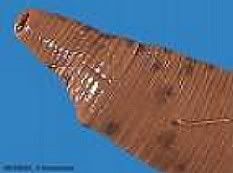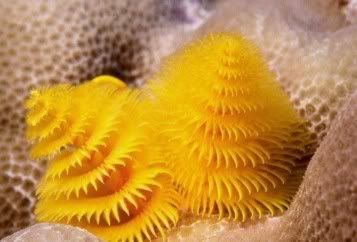Circulatory/Internal Transport:
The circulatory system varies among the different members of annelids. Most have blood with hemoglobin, a red pigment that carries oxygen, but some others have a green pigment that carries oxygen, or unpigmented blood. Most segmented worms (such as earthworms) have a closed circulatory system which means the blood circulates only within a system of blood vessels, rather than mixing with fluid in the body cavity. In each of the segments in the body of the annelid, there is a pair of smaller vessels called ring vessels. The ring vessels connect the dorsal and ventral vessels of the annelid and supply blood to some small internal organs and transports blood from the anterior to the posterior. There are 10 main ring vessels located on top of the gut that serve as hearts. In leeches, the closed circulatory system is reduced or absent and it may be replaced by coelomic canals. In other annelids, blood is helped moved around the body by muscle contractions when the annelid is moving itself.

The leech’s pharynx is used to suck blood.

Anatomy of an Earthworm
Feeding:
Feeding styles vary from eating organic material that settles on the surface of the muddy substrate (detritus feeding), to filtering plankton, sucking blood out of other animals (parasitic) and detritus from the water using feathery feeding tentacles (suspension feeding), to eating their neighbors (predation).

The filter feeder plume worm
Digestion:
Segmented worms have a gut that runs the length of the body, and is separated from the body wall by the coelom. Food enters the mouth and travels through the gut, where it is digested. An important feeding organ that has evolved in most annelids is the pharynx. The pharynx is the muscular front end of the digestive system. In carnivorous annelids, such as the sandworm, the pharynx has two or more sharp jaws which are useful for capturing prey. Herbivores also have this jaw used for tearing algae. In detritus feeders, such as earthworms, the pharynx acts as a pump to allow water and soil enter the earthworm. In parasites, such as leeches, the pharynx is used to suck blood out of its host. In the some filter feeder annelids, they use their long tube like burrows to catch passing algae in the ocean.
Excretion:
Annelids produce two types of wastes—solid and liquid. Solid wastes are removed from the gut through the anus and liquid wastes are removed by tube-shaped oranges called nephridia. These organs act very similar to kidneys and remove urea. A pair of nephirdia are present in each body segment and removes waste products from body fluids and excretes them.
Cites:
Biology textbook
http://www.tolweb.org/articles/?article_id=57
http://ebiomedia.com/prod/BOanelids.html
Leech:
http://biodidac.bio.uottawa.ca
Earthworm anatomy:
http://concise.britannica.com
Plume worm:
http://www.ryanphotographic.com


0 Comments:
Post a Comment
Subscribe to Post Comments [Atom]
<< Home